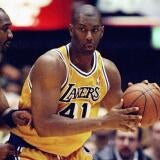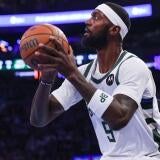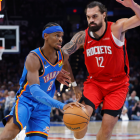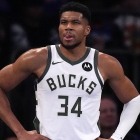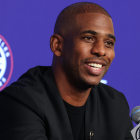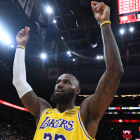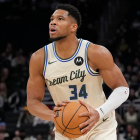2017 NBA Mock Draft: Lonzo Ball to Lakers after Celtics take Markelle Fultz at No. 1
Gary Parrish's mock draft will make Lavar Ball happy with Lonzo going to the Lakers at No. 2

The combination of a brilliant trade made years ago and favorable pingpong balls that bounced Tuesday night allowed the Eastern Conference's No. 1 seed to secure the NBA Draft's No. 1 pick. So the Celtics will be selecting first next month. Which means a good roster by any standard is now guaranteed to get better.
Credit GM Danny Ainge.
And how about this quote from Mikhail Prokhorov!
"Today, the basketball gods smiled on the Nets," Prokhorov said on July 12, 2013, when his franchise traded its 2014, 2016 and 2018 first-round picks to Boston while also giving the Celtics the opportunity to swap first-round picks in 2017.
Fast-forward to the present, and the Nets stink while Boston is in the Eastern Conference Finals and preparing to select whichever prospect they desire in one of the deepest and best drafts in years. So it seems pretty clear that the basketball gods did not in fact smile on the Nets back in July 2013. In reality, the Nets just got taken advantage of by the Celtics. And this is the result.
| 1 | |
Markelle Fultz, PG, Washington: Ainge said Tuesday that things haven't been "narrowed down to one or two guys." And I believe him, I guess. But the primary focus has to be Fultz — the one-and-done point guard from Washington who has good size for the position, terrific instincts and a reliable jumper. Yes, he can play with Isaiah Thomas. Yes, he'll be great. | |
| 2 | |
Lonzo Ball, PG, UCLA: The Ball family — mostly LaVar but also Lonzo — has made it clear they want to be Lakers. And now, barring a surprise, they'll likely get their wish. The UCLA star should stay in LA. And did you notice Lakers president Magic Johnson didn't look too upset about not getting the No. 1 pick? That's because, I think, he knows the pressure is off. He doesn't have to pick between Ball and Fultz. Now he can just take Ball once Fultz is off the board. And the Lakers are suddenly interesting again, if nothing else. | |
| 3 | |
Josh Jackson, SF, Kansas: Jackson didn't get the attention that some of the other freshmen got this season — and he wasn't even the best player on his team. (That was Frank Mason.) But the 6-8 wing was tremendous while averaging 16.3 points, 7.4 rebounds and 3.0 assists in his lone year of college. He projects as a high-level contributor on both the offensive and defensive ends of the court. He'll make the Sixers more athletic, right from the jump. | |
| 4 | |
Jayson Tatum, SF, Duke: Tatum should in time become a high-scoring wing at the NBA level. The 6-8 athlete averaged 16.8 points and 7.3 rebounds — after missing the first eight games of the season with a foot injury — and ultimately helped Duke win the 2017 ACC Tournament. The only thing missing, right now, is a reliable 3-point shot that scouts believe can be developed. So that's not a major concern. Put him next to Devin Booker, and the Suns could have the pieces to be good again. | |
| 5 | |
De'Aaron Fox, PG, Kentucky: The Kings are in need of a young point guard with a high ceiling, and Fox is exactly that. At 6-4, he has nice size for the position and is super-fast with the ball. He was sensational in a Sweet 16 win over UCLA while finishing with 39 points. And though his 24.6 3-point percentage is a concern, it's neither something that can't be improved nor the type of thing that should prevent Sacramento from selecting him here. | |
| 6 | |
| Malik Monk, SG, Kentucky: The Magic shot 32.8 percent from 3-point range this season, which ranked next-to-last in the NBA. So they need shooting in the worst way. And Monk could provide it. The athletic combo guard made 39.7 percent of his 3-point attempts this season while averaging a team-high 19.8 points for a Kentucky team that won the SEC. Why he doesn't use his athleticism more to get into the lane consistently remains a mystery. But if Monk ever does that, he could develop into an All-Star. | |
| 7 | |
Jonathan Isaac, SF, Florida State: The Timberwolves could take Isaac, play him with Karl-Anthony Towns and Andrew Wiggins, and now we're talking about something with potential. Minnesota would then have a core of Isaac, Towns, Wiggins, Zach LaVine and Ricky Rubio -- some nice pieces that could soon have the Timberwolves advancing in the NBA Playoffs. | |
| 8 | |
Dennis Smith Jr., PG, NC State: The Knicks are a mess and in need of basically everything -- including the point guard help that Smith would bring. At 6-3, he has nice size for the position and is explosive with the ball. The NC State product averaged 18.1 points, 6.2 assists and 4.6 rebounds in his one season of college basketball. He could be enough to make Kristaps Porzingis comfortable with a future in New York. | |
| 9 | |
Lauri Markkanen, PF, Arizona: Markkanen is a modern-day stretch-4 who shot 42.3 percent from 3-point range this season. It's hard to imagine him slipping outside of the top 10 and, frankly, I won't be surprised if he ends up going in the top five. Either way, wouldn't it be cool to watch him work under Dirk Nowitzki for a year or two? | |
| 10 | |
Justin Jackson, SF, North Carolina: If Sacramento is going to take a point guard who can't shoot with the fifth pick, it makes sense to take a wing who can with the 10th. So Jackson makes sense. The 6-8 former North Carolina star shot a career-high 37.0 percent from 3-point range this season, which greatly enhanced his NBA stock. He's a national champion who should be able to contribute immediately at a position of need for the Kings. | |
| 11 | |
Frank Ntilikina, PG, France: Ntilikina is 6-5 and thus obviously capable of playing with Kemba Walker. And, at this point in the draft, he's a steal. So the Hornets would be wise to snatch him up and be happy with the fact that they're getting a possible top-five pick in another draft outside of the top 10 in this one. | |
| 12 | |
Zach Collins, PF, Gonzaga: Collins is the first one-and-done player in Gonzaga history and could work well playing next to Andre Drummond. The 7-foot forward shot 47.6 percent from the 3-point line on the season -- and finished with 14 points, 13 rebounds and six blocks in the Zags' national semifinal win over South Carolina. Those numbers and that performance on such a big stage helped secure a place in the top 20 of this draft, guaranteed. | |
| 13 | |
Justin Patton, C, Creighton: Patton is the rare one-and-done redshirt freshman. He's a 7-foot forward who averaged 12.9 points and 6.2 rebounds in just 25.3 minutes while helping Creighton stay ranked for much of the season despite the loss of Maurice Watson. He's a work in progress, sure. But he's also a player with an undeniably high ceiling. | |
| 14 | |
OG Anunoby, SF, Indiana: Anunoby suffered a season-ending knee injury in January, which will cost him with some franchises. But the 6-8 wing remains a lottery talent and should be evaluated as such. He's probably a top-10 pick if not for the medical setback. His ability to guard multiple positions could make him special in time. | |
| 15 | |
TJ Leaf, PF, UCLA: Leaf averaged 16.3 points and 8.2 rebounds while shooting 46.6 percent from 3-point range this season. He was overshadowed by his teammates at UCLA but still a statistical monster. He's a perfect stretch-4 for the modern-day NBA. Damian Lillard could use him in Portland the way Kyrie Irving uses Kevin Love in Cleveland. | |
| 16 | |
Terrance Ferguson, SG, Australia: Ferguson, as expected, was inconsistent while playing in Australia this season. But that shouldn't affect his standing with NBA scouts too much. He only shot 31.3 percent from 3-point range in 30 games. Not good. But that's not an accurate reflection of how well the former Arizona signee can actually shoot from beyond the arc. | |
| 17 | |
Donovan Mitchell, SG, Louisville: Mitchell had a breakout season and averaged 15.6 points and 4.9 rebounds for a Louisville team that won 25 games. He's an undersized but strong shooting guard with above-average athleticism who could fit nicely next to Giannis Antetokounmpo in Milwaukee. | |
| 18 | |
Jarrett Allen, C, Texas: Allen was a better prospect than player in his one year at Texas. But the 6-11 athlete was consistently good from February on and showed flashes of why he's worthy of being selected in the top 20. He and Myles Turner would give the Pacers two nice young bigs to build around -- with or without Paul George. | |
| 19 | |
John Collins, PF, Wake Forest: Collins was ranked 230th in the Class of 2015, according to 247Sports. But he still developed into a player who averaged 19.2 points and 9.8 rebounds this season and emerged as a legitimate NBA prospect. In other words, he's one of this draft's most surprising stories and the type of thing Wake Forest coach Danny Manning can use to influence recruits going forward. | |
| 20 | |
Harry Giles, PF, Duke: At some point somebody will take a flyer on Giles and rationalize it by stating he would've been a top-five pick a year ago. Will Giles ever become what so many projected him to become -- i.e., the next Chris Webber? Honestly, I'm not sure. But he might. So he's worth a gamble in the 20s. | |
| 21 | |
Luke Kennard, SG, Duke: Oklahoma City shot a league-low 32.7 percent from 3-point range this season, which is obviously something Kennard could help improve. The 6-6 guard was among college basketball's biggest breakout stars this season while averaging 19.5 points and shooting 43.8 percent from 3-point range for Duke. Russell Westbrook's ability to draw defenders would lead to open looks for Kennard. And the numbers suggest open looks for Kennard tend to lead to easy points. | |
| 22 | |
Ivan Rabb, PF, California: Rabb returned to California for his sophomore season in part so that he could improve his stock. That didn't really happen. But he's still a first-round talent and intriguing prospect. The 6-11 forward averaged 14.0 points and 10.5 rebounds this season for a Cal team that was likely one or two wins away from making the NCAA Tournament. | |
| 23 | |
Tyler Lydon, SF, Syracuse: Lydon shot 40.0 percent from 3-point range in two seasons at Syracuse and averaged 13.2 points and 8.6 rebounds as a sophomore. He'll be a stretch-4 in the NBA and capable of cracking a rotation as a rookie thanks to that reliable jumper. | |
| 24 | |
Ike Anigbogu, PF, UCLA: Anigbogu only played 13.0 minutes per game for UCLA, which suggests he's nowhere close to contributing at the NBA level. But he's still an interesting prospect who is only 18 years old. His tenacity and toughness should get him picked in the first round. | |
| 25 | |
Rodions Kurucs, SF, Spain: The Magic have two first-round picks. So they could use this one on a draft-and-stash option. And Kurucs, a 19 year old from Latvia, is a solid candidate for such. He's 6-8, can play either forward position and make shots from the perimeter. | |
| 26 | |
Jonathan Jeanne, C, France: Jeanne is a work in progress who isn't even a top player for his club team. But he's 7-2 with a 7-6 wingspan -- and a good athlete. So the upside is undeniable and worthy of a flyer in the first round. | |
| 27 | |
Caleb Swanigan, PF, Purdue: There has to be a place in the NBA for anybody who produces at the high-major level the way Swanigan did this season. The 6-9 forward averaged 18.5 points and 12.5 rebounds for the outright Big Ten champions and was a consensus first-team All-American. And the fact that he shot 44.7 percent from 3-point range suggests he's equipped to step away from the basket at the NBA level too. | |
| 28 | |
Semi Ojeleye, SF, SMU: Ojeleye started his college career at Duke, where he was just a bit player. But the 6-7 forward was tremendous at SMU this season. He averaged 19.0 points and 6.9 rebounds while leading the Mustangs to American Athletic Conference regular-season and tournament titles. He was the AAC Player of the Year. | |
| 29 | |
Isaiah Hartenstein, PF, Germany: Hartenstein was reportedly just OK at the Nike Hoop Summit and thus didn't do much to enhance his reputation with NBA scouts. Still, it's hard to imagine him not going somewhere in the first round. And San Antonio's history with international prospects suggests he would fit nicely in that organization. | |
| 30 | |
Josh Hart, SG, Villanova: Not every junior who returns for his senior year actually improves his reputation with NBA scouts. But Hart did. He averaged 18.7 points and 6.4 rebounds while shooting 40.4 percent from 3-point range for a Villanova team that was the No. 1 overall seed in the NCAA Tournament. | |

























